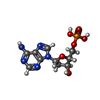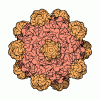+ Open data
Open data
- Basic information
Basic information
| Entry | Database: EMDB / ID: EMD-23516 | |||||||||
|---|---|---|---|---|---|---|---|---|---|---|
| Title | Hum8 capsid | |||||||||
 Map data Map data | ||||||||||
 Sample Sample |
| |||||||||
 Keywords Keywords | Icosahedral Capsid / AAV8 / Hum8 / capsid engineering / Adeno-associated virus / Parvovirus / Gene Therapy / VIRUS | |||||||||
| Function / homology |  Function and homology information Function and homology informationT=1 icosahedral viral capsid / nucleotide binding / structural molecule activity Similarity search - Function | |||||||||
| Biological species |  Adeno-associated virus - 8 / Adeno-associated virus - 8 /   Adeno-associated virus Adeno-associated virus | |||||||||
| Method | single particle reconstruction / cryo EM / Resolution: 2.49 Å | |||||||||
 Authors Authors | Mietzsch M / Agbandje-McKenna M | |||||||||
| Funding support |  United States, 1 items United States, 1 items
| |||||||||
 Citation Citation |  Journal: J Virol / Year: 2021 Journal: J Virol / Year: 2021Title: Receptor Switching in Newly Evolved Adeno-associated Viruses. Authors: L Patrick Havlik / Anshuman Das / Mario Mietzsch / Daniel K Oh / Jonathan Ark / Robert McKenna / Mavis Agbandje-McKenna / Aravind Asokan /  Abstract: Adeno-associated viruses utilize different glycans and the AAV receptor (AAVR) for cellular attachment and entry. Directed evolution has yielded new AAV variants; however, structure-function ...Adeno-associated viruses utilize different glycans and the AAV receptor (AAVR) for cellular attachment and entry. Directed evolution has yielded new AAV variants; however, structure-function correlates underlying their improved transduction are generally overlooked. Here, we report that infectious cycling of structurally diverse AAV surface loop libraries yields functionally distinct variants. Newly evolved variants show enhanced cellular binding, uptake, and transduction, but through distinct mechanisms. Using glycan-based and genome-wide CRISPR knockout screens, we discover that one AAV variant acquires the ability to recognize sulfated glycosaminoglycans, while another displays receptor switching from AAVR to integrin β1 (ITGB1). A previously evolved variant, AAVhum.8, preferentially utilizes the ITGB1 receptor over AAVR. Visualization of the AAVhum.8 capsid by cryoelectron microscopy at 2.49-Å resolution localizes the newly acquired integrin recognition motif adjacent to the AAVR footprint. These observations underscore the new finding that distinct AAV surface epitopes can be evolved to exploit different cellular receptors for enhanced transduction. Understanding how viruses interact with host cells through cell surface receptors is central to discovery and development of antiviral therapeutics, vaccines, and gene transfer vectors. Here, we demonstrate that distinct epitopes on the surface of adeno-associated viruses can be evolved by infectious cycling to recognize different cell surface carbohydrates and glycoprotein receptors and solve the three-dimensional structure of one such newly evolved AAV capsid, which provides a roadmap for designing viruses with improved attributes for gene therapy applications. | |||||||||
| History |
|
- Structure visualization
Structure visualization
| Movie |
 Movie viewer Movie viewer |
|---|---|
| Structure viewer | EM map:  SurfView SurfView Molmil Molmil Jmol/JSmol Jmol/JSmol |
| Supplemental images |
- Downloads & links
Downloads & links
-EMDB archive
| Map data |  emd_23516.map.gz emd_23516.map.gz | 262.8 MB |  EMDB map data format EMDB map data format | |
|---|---|---|---|---|
| Header (meta data) |  emd-23516-v30.xml emd-23516-v30.xml emd-23516.xml emd-23516.xml | 15.6 KB 15.6 KB | Display Display |  EMDB header EMDB header |
| Images |  emd_23516.png emd_23516.png | 323.2 KB | ||
| Filedesc metadata |  emd-23516.cif.gz emd-23516.cif.gz | 6.3 KB | ||
| Archive directory |  http://ftp.pdbj.org/pub/emdb/structures/EMD-23516 http://ftp.pdbj.org/pub/emdb/structures/EMD-23516 ftp://ftp.pdbj.org/pub/emdb/structures/EMD-23516 ftp://ftp.pdbj.org/pub/emdb/structures/EMD-23516 | HTTPS FTP |
-Validation report
| Summary document |  emd_23516_validation.pdf.gz emd_23516_validation.pdf.gz | 739.9 KB | Display |  EMDB validaton report EMDB validaton report |
|---|---|---|---|---|
| Full document |  emd_23516_full_validation.pdf.gz emd_23516_full_validation.pdf.gz | 739.4 KB | Display | |
| Data in XML |  emd_23516_validation.xml.gz emd_23516_validation.xml.gz | 7.6 KB | Display | |
| Data in CIF |  emd_23516_validation.cif.gz emd_23516_validation.cif.gz | 8.8 KB | Display | |
| Arichive directory |  https://ftp.pdbj.org/pub/emdb/validation_reports/EMD-23516 https://ftp.pdbj.org/pub/emdb/validation_reports/EMD-23516 ftp://ftp.pdbj.org/pub/emdb/validation_reports/EMD-23516 ftp://ftp.pdbj.org/pub/emdb/validation_reports/EMD-23516 | HTTPS FTP |
-Related structure data
| Related structure data |  7ltmMC M: atomic model generated by this map C: citing same article ( |
|---|---|
| Similar structure data |
- Links
Links
| EMDB pages |  EMDB (EBI/PDBe) / EMDB (EBI/PDBe) /  EMDataResource EMDataResource |
|---|---|
| Related items in Molecule of the Month |
- Map
Map
| File |  Download / File: emd_23516.map.gz / Format: CCP4 / Size: 282.6 MB / Type: IMAGE STORED AS FLOATING POINT NUMBER (4 BYTES) Download / File: emd_23516.map.gz / Format: CCP4 / Size: 282.6 MB / Type: IMAGE STORED AS FLOATING POINT NUMBER (4 BYTES) | ||||||||||||||||||||||||||||||||||||||||||||||||||||||||||||||||||||
|---|---|---|---|---|---|---|---|---|---|---|---|---|---|---|---|---|---|---|---|---|---|---|---|---|---|---|---|---|---|---|---|---|---|---|---|---|---|---|---|---|---|---|---|---|---|---|---|---|---|---|---|---|---|---|---|---|---|---|---|---|---|---|---|---|---|---|---|---|---|
| Projections & slices | Image control
Images are generated by Spider. | ||||||||||||||||||||||||||||||||||||||||||||||||||||||||||||||||||||
| Voxel size | X=Y=Z: 1.096 Å | ||||||||||||||||||||||||||||||||||||||||||||||||||||||||||||||||||||
| Density |
| ||||||||||||||||||||||||||||||||||||||||||||||||||||||||||||||||||||
| Symmetry | Space group: 1 | ||||||||||||||||||||||||||||||||||||||||||||||||||||||||||||||||||||
| Details | EMDB XML:
CCP4 map header:
| ||||||||||||||||||||||||||||||||||||||||||||||||||||||||||||||||||||
-Supplemental data
- Sample components
Sample components
-Entire : Adeno-associated virus
| Entire | Name:   Adeno-associated virus Adeno-associated virus |
|---|---|
| Components |
|
-Supramolecule #1: Adeno-associated virus
| Supramolecule | Name: Adeno-associated virus / type: virus / ID: 1 / Parent: 0 / Macromolecule list: #1 / NCBI-ID: 272636 / Sci species name: Adeno-associated virus / Sci species strain: Hum8 / Virus type: VIRION / Virus isolate: OTHER / Virus enveloped: No / Virus empty: No |
|---|
-Macromolecule #1: Capsid protein
| Macromolecule | Name: Capsid protein / type: protein_or_peptide / ID: 1 / Number of copies: 60 / Enantiomer: LEVO |
|---|---|
| Source (natural) | Organism:  Adeno-associated virus - 8 Adeno-associated virus - 8 |
| Molecular weight | Theoretical: 58.491398 KDa |
| Recombinant expression | Organism:  Homo sapiens (human) Homo sapiens (human) |
| Sequence | String: DGVGSSSGNW HCDSTWLGDR VITTSTRTWA LPTYNNHLYK QISNGTSGGA TNDNTYFGYS TPWGYFDFNR FHCHFSPRDW QRLINNNWG FRPKRLSFKL FNIQVKEVTQ NEGTKTIANN LTSTIQVFTD SEYQLPYVLG SAHQGCLPPF PADVFMIPQY G YLTLNNGS ...String: DGVGSSSGNW HCDSTWLGDR VITTSTRTWA LPTYNNHLYK QISNGTSGGA TNDNTYFGYS TPWGYFDFNR FHCHFSPRDW QRLINNNWG FRPKRLSFKL FNIQVKEVTQ NEGTKTIANN LTSTIQVFTD SEYQLPYVLG SAHQGCLPPF PADVFMIPQY G YLTLNNGS QAVGRSSFYC LEYFPSQMLR TGNNFQFTYT FEDVPFHSSY AHSQSLDRLM NPLIDQYLYY LSRTQTTSNG RG VTLGFSQ GGPNTMANQA KNWLPGPCYR QQRVSTYPLQ NNNSNFAWTA GTKYHLNGRN SLANPGIAMA THKDDEERFF PSN GILIFG KQNAARDNAD YSDVMLTSEE EIKTTNPVAT EEYGIVADNG QTQTTAPQIG TVNSQGALPG MVWQNRDVYL QGPI WAKIP HTDGNFHPSP LMGGFGLKHP PPQILIKNTP VPADPRSTFN GDKLNSFITQ YSTGQVSVEI EWELQKENSK RWNPE IQYT SNYYKSTSVD FAVNTEGVYS EPRPIGTRYL TRNL UniProtKB: Capsid protein |
-Macromolecule #2: 2'-DEOXYADENOSINE-5'-MONOPHOSPHATE
| Macromolecule | Name: 2'-DEOXYADENOSINE-5'-MONOPHOSPHATE / type: ligand / ID: 2 / Number of copies: 60 / Formula: D5M |
|---|---|
| Molecular weight | Theoretical: 331.222 Da |
| Chemical component information |  ChemComp-D5M: |
-Experimental details
-Structure determination
| Method | cryo EM |
|---|---|
 Processing Processing | single particle reconstruction |
| Aggregation state | particle |
- Sample preparation
Sample preparation
| Buffer | pH: 7.4 |
|---|---|
| Vitrification | Cryogen name: ETHANE |
- Electron microscopy
Electron microscopy
| Microscope | FEI TITAN KRIOS |
|---|---|
| Image recording | Film or detector model: GATAN K3 (6k x 4k) / Average electron dose: 60.0 e/Å2 |
| Electron beam | Acceleration voltage: 300 kV / Electron source:  FIELD EMISSION GUN FIELD EMISSION GUN |
| Electron optics | Illumination mode: FLOOD BEAM / Imaging mode: BRIGHT FIELD / Cs: 2.7 mm |
| Experimental equipment |  Model: Titan Krios / Image courtesy: FEI Company |
 Movie
Movie Controller
Controller

















 Z (Sec.)
Z (Sec.) X (Row.)
X (Row.) Y (Col.)
Y (Col.)





















